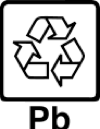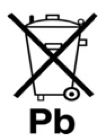Used Lead Acid Batteries (ULAB)
Applications
- Mature technology.
- Commonly used in automobiles.
Components
- Lead, lead oxide, sulphuric acid, plastics (PP)
Risks/hazards
- Exposure to lead, a toxic substance that can cause a wide variety of serous health effects, particularly in children
- Fire: if damaged or terminals short circuit
- Acid related injuries: if acid spills
- Corrosion
- Heavy lifting
- Disposal to landfill can result in local environmental contamination
Storage of used button cell batteries in the home
- Cover terminals with tape to prevent short circuit and minimise risk of fire
- Store out of reach and stored out of each of children
- Keep upright
- Take care when lifting
Recyclability
- Used lead acid batteries (ULAB) are recyclable
- Materials contained in ULABs have a commercial value.
- Close to 100% of the materials can be recycled and there is a well-established infrastructure for collection and recycling.
- Plastics and electrolyte (H2SO4) are also recovered.
- Collection from remote areas is less commercially viable due to the cost of transport.
Collection rate
- Currently we collect about 90% of used lead acid batteries in Australia for recycling
Recycling rate
- 99%
Legal requirements (Always check your own legal requirements as these vary from state to state)
Label


UN Number
- Batteries, wet, filled with acid: 2794
- Batteries, wet, non-spillable: 2800 (sealed)
Manufacturers
- Century Yuasa Batteries
- Pacific Marine
- The remainder are imported.
Health and safety
- Follow manufacturers’ guidelines for safe handling and storage.
- ABRI has published a series of information sheets at: www.batteryrecycling.org.au/recycling/automotive-batteries
Packaging for transport
- ABRI has published a voluntary packaging standard for packing Used Lead Acid Batteries at www.batteryrecycling.org.au


